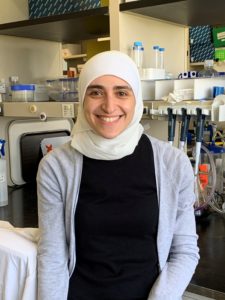Research Interests
My research focuses on mapping host-pathogen interactions of influenza viruses and coronaviruses in order to identify and validate novel host targets for therapeutic intervention. While much is known about the function of each influenza virus-encoded protein during replication, we have a limited understanding of how the host cell facilitates viral replication. Influenza virus, therefore, continues to cause epidemic infections as well as pandemics every 10-50 years. In parallel, there have been three coronavirus infection outbreaks within the past two decades caused by MERS, SARS-CoV, and SARS-CoV-2. Our limited insight into host-pathogen interactions of these coronaviruses has hindered our ability to develop potential therapeutics. As such, studying the biology of both influenza virus and coronavirus infections will unveil novel host targets that could be exploited to develop new effective antivirals and vaccines.
Notable Publications
El Zahed SS, French S, Farha MA, Kumar G, Brown ED. 2021. Physicochemical and structural parameters contributing to the antibacterial activity and efflux susceptibility of small-molecule inhibitors of Escherichia coli. Antimicrob Agents Chemother 65:e01925-20.
Tong M, French S, El Zahed SS, Ong Wk, Karp PD, Brown ED. 2020. Gene dispensability in Escherichia coli grown in thirty different carbon environments. mBio 11:e02259-20.
Farha MA, MacNair CR, Carfrae LA, El Zahed SS, Ellis MJ, Tran H-KR, McArthur AG, Brown ED. 2020. Overcoming acquired and native macrolide resistance with bicarbonate. ACS Infect Dis 6:2709-2718.
El Zahed SS, Kumar G, Tong M, Brown ED. 2018. Nutrient stress small-molecule screening platform for Escherichia coli, p 1-18. In Wagner B (ed), Phenotypic Screening: Methods and Protocols, vol 1787. Springer New York, New York, NY.
El Zahed SS, Brown ED. 2018. Chemical-chemical combinations map uncharted interactions in Escherichia coli under nutrient stress. iScience 2:168-181.

